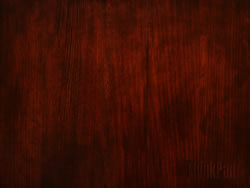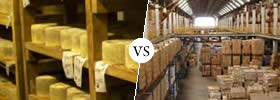Difference between Walnut and Cherry Wood
Key difference: Walnut and cherry wood are two different types of hardwoods. Walnut wood is mainly sourced from trees belonging to the Juglans genus of trees. As a wood, walnut tends to have a hard, dense, and tight grain which has a smooth finish when polished. The grain usually tends to be straight; however it can be irregular at times. The sapwood of walnut has a creamy white hue, while the heartwood tends to be more dark chocolate in color. Cherry wood is the wood of the cherry tree, which is officially part of the Prunus genus of trees and shrubs. Cherry wood has a reddish brown hue with a golden luster. When the wood is cut, it is very pale in color but the wood tends to become darker and richer with age, and eventually takes on its famous rich brown red shade.
 Walnut and cherry wood are two different types of hardwoods. Basically, hardwood is the wood that comes from an angiosperm tree. This is a type of tree that has seeds that are enclosed, be it in pods, a shell, a covering or in a fruit. For example, apples or nuts and seeds like acorns and walnuts. These types of seeds allow birds and insects to be attracted to the flowers of the tree and be able to carry the pollen to other trees. This is also the reason why hardwood trees are not often bunched together but are spaced apart and often have other trees in-between them.
Walnut and cherry wood are two different types of hardwoods. Basically, hardwood is the wood that comes from an angiosperm tree. This is a type of tree that has seeds that are enclosed, be it in pods, a shell, a covering or in a fruit. For example, apples or nuts and seeds like acorns and walnuts. These types of seeds allow birds and insects to be attracted to the flowers of the tree and be able to carry the pollen to other trees. This is also the reason why hardwood trees are not often bunched together but are spaced apart and often have other trees in-between them.
Most hardwood trees are also deciduous is nature. A deciduous tree is a tree that loses its leaves annually. Hardwood trees are also slower to grow, taking their own time. Due to this, most hardwood is dense. This is also the reason that hardwood is expensive, as it takes longer to grow. Some famous hardwoods include maple, walnut, oak, elm, mahogany, and sycamore.
Walnut wood is mainly sourced from trees belonging to the Juglans genus of trees. There are approximately 21 species in the genus which are located all over the world, including southeast Europe to Japan, as well as from southeast Canada to California and to Argentina. However, the most commonly used walnut wood is the American Black Walnut. Less commonly used are the Butternut, Claro Walnut, English Walnut, and the Peruvian Walnut.
As a wood, walnut tends to have a hard, dense, and tight grain which has a smooth finish when polished. The grain usually tends to be straight; however it can be irregular at times.
The sapwood of walnut has a creamy white hue, while the heartwood tends to be more dark chocolate in color. The wood will take on a more dull brown color if it is kiln-dried or a rich purplish-brown if air-dried.
Walnut tends to be durable and is resistant to decay. This makes the wood quite popular for furniture and as a carving wood. Still, walnut can be susceptible to insect attack. Walnut burls or burrs are also commonly used for turning wood pieces, such as bowls, as well as making veneers. Walnut is also commonly used for rifle and shotgun stocks, as walnut is resistant to compression along the grain. In addition, Walnut is also commonly used in making stringed instruments.
 Cherry wood is the wood of the cherry tree, which is officially part of the Prunus genus of trees and shrubs. Cherry wood has a reddish brown hue with a golden luster. When the wood is cut, it is very pale in color but the wood tends to become darker and richer with age, and eventually takes on its famous rich brown red shade.
Cherry wood is the wood of the cherry tree, which is officially part of the Prunus genus of trees and shrubs. Cherry wood has a reddish brown hue with a golden luster. When the wood is cut, it is very pale in color but the wood tends to become darker and richer with age, and eventually takes on its famous rich brown red shade.
Cherry wood is also often referred to as Black cherry, Capulin, Cherry, Chisos wild cherry, Choke cherry, Edwards Plateau cherry, Escarpment cherry, Gila choke cherry, Mountain black cherry, New England mahogany, Plum, Rum cherry, Southwestern chokecherry, Whiskey cherry, and/or Wild black cherry.
Cherry wood is fine textured, strong and fairly durable. It is also easy to work. This makes the wood extremely popular with cabinetmakers. In addition to cabinets, the wood is also used to make other furniture, as well as in wood bending and turning. It is also used to make veneer, interior millwork, and small accessories.
As a wood, cherry tends to be slightly softer than other hardwoods, such as maple. However, it is more capable of absorbing a stain or a glaze, hence the finished product has a more even stain finish. The wood also has a distinct grain pattern running through it due to the incorporating on the sapwood and hardwood into the timber, which may not be appealing to everyone.
Image Courtesy: thesolidwoodflooringcompany.com, floridacustomclosets.com









Add new comment